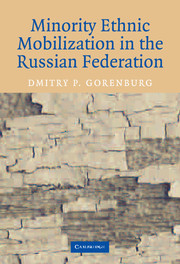Book contents
- Frontmatter
- Contents
- List of Figures and Tables
- Preface
- 1 Minority Ethnic Mobilization in Russia: An Introduction
- 2 Explaining Ethnic Mobilization: The Role of Ethnic Institutions
- 3 From Cultural Society to Popular Front: The Formation and Development of Nationalist Organizations
- 4 The Soviet Institutional Legacy and Ethno-Nationalist Ideology
- 5 Institutions Matter: Measuring Support for Nationalism
- 6 Intragroup Variation in Support for Nationalism: Not All Ethnics Are the Same
- 7 Outcomes: Did Regional Governments Adopt the Nationalist Agenda?
- 8 The Larger Picture: Support for Nationalism in Russia's Other Republics
- 9 Institutions and Nationalism
- Appendix: Construction of Variables and Indices
- References
- Index
4 - The Soviet Institutional Legacy and Ethno-Nationalist Ideology
Published online by Cambridge University Press: 15 December 2009
- Frontmatter
- Contents
- List of Figures and Tables
- Preface
- 1 Minority Ethnic Mobilization in Russia: An Introduction
- 2 Explaining Ethnic Mobilization: The Role of Ethnic Institutions
- 3 From Cultural Society to Popular Front: The Formation and Development of Nationalist Organizations
- 4 The Soviet Institutional Legacy and Ethno-Nationalist Ideology
- 5 Institutions Matter: Measuring Support for Nationalism
- 6 Intragroup Variation in Support for Nationalism: Not All Ethnics Are the Same
- 7 Outcomes: Did Regional Governments Adopt the Nationalist Agenda?
- 8 The Larger Picture: Support for Nationalism in Russia's Other Republics
- 9 Institutions and Nationalism
- Appendix: Construction of Variables and Indices
- References
- Index
Summary
When the Communist Party created the Soviet Union's ethno-federal state structure in the 1920s, its goal was to persuade minority ethnic groups to accept communism by packaging it with the end of oppressive tsarist policies directed against the country's non-Russian population. For this reason, immediately after the October revolution, Lenin's government issued a “Declaration of the Rights of the Peoples of Russia,” which guaranteed minorities sovereignty, self-determination, equality, and the right to cultural development. During the formative years of the Soviet state, government policy toward ethnic minorities established formal autonomy while ensuring that this autonomy would be used to establish socialist governments (Nahaylo and Swoboda 1990, 18–19). “Language and other manifestations of national uniqueness … were merely forms. It was the party, acting through the state, which would give them content.” (Connor 1984, 202) This policy was characterized by the slogan, “national in form, socialist in content.” The government sought to institutionalize ethnicity in order to promote and institutionalize communism among the non-Russian population.
The longevity of the Soviet state gave its ethnic institutions a high level of legitimacy among the population. At the same time, the lack of ethnic content in the ethnic regions of the country served as a major source of dissatisfaction with Soviet rule among the regions' titular inhabitants. The nationalist movements that emerged during perestroika thus had to work within the framework of these institutions in order to create a new nationalist ideology based on increasing the level of ethnic content within the existing ethnic forms.
- Type
- Chapter
- Information
- Minority Ethnic Mobilization in the Russian Federation , pp. 77 - 117Publisher: Cambridge University PressPrint publication year: 2003



